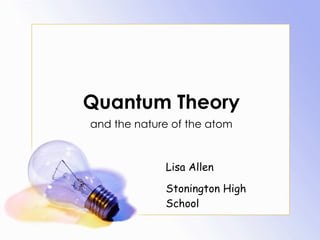Quantum Theory: Unlocking the Mysteries of the Subatomic World
Introduction:
Quantum Theory, also known as Quantum Mechanics, is one of the most profound and revolutionary scientific theories ever developed. It represents a fundamental shift in our understanding of the universe, delving into the mysterious and counterintuitive behavior of the subatomic world. In this blog, we will embark on a journey into the fascinating realm of Quantum Theory and explore how it has shaped modern physics and transformed our perception of reality.
The Birth of Quantum Theory:
The origins of Quantum Theory can be traced back to the late 19th and early 20th centuries when physicists faced perplexing problems while trying to understand the behavior of atoms and subatomic particles. Classical physics, which had successfully described the macroscopic world, failed to explain the unusual phenomena observed at the atomic level.
The breakthrough came in the early 1900s when a series of revolutionary ideas and experiments began to challenge conventional wisdom. Scientists like Max Planck, Albert Einstein, Niels Bohr, Werner Heisenberg, Erwin Schrödinger, and others played pivotal roles in the development of Quantum Theory.
Key Principles of Quantum Theory:
Quantization of Energy: Max Planck's work on blackbody radiation revealed that energy is quantized, meaning it can only exist in discrete units called "quanta." This concept contradicted the classical view of continuous energy levels.
Wave-Particle Duality: Albert Einstein and others demonstrated that light and other particles, like electrons, exhibit both wave-like and particle-like behaviors. This duality challenged our classical understanding of particles as discrete, localized entities.
Uncertainty Principle: Proposed by Werner Heisenberg, the Uncertainty Principle states that it is impossible to simultaneously know both the position and momentum of a particle with absolute precision. The more accurately one property is measured, the less accurately the other can be known.
Quantum Superposition: Erwin Schrödinger's wave equation described how particles, such as electrons, can exist in multiple states simultaneously, known as quantum superposition, until measured or observed.
The Schrödinger Equation and Wavefunctions:
Erwin Schrödinger's wave equation is a central pillar of Quantum Theory. It mathematically describes the behavior of quantum systems and provides a way to calculate the probabilities of various outcomes when measurements are made. The solutions to the Schrödinger equation are wavefunctions, which contain valuable information about the quantum states of particles.
Quantum Entanglement and Nonlocality:
Quantum Theory also gave rise to the concept of quantum entanglement, where two or more particles become connected in such a way that the state of one particle is directly related to the state of the others, regardless of the distance between them. This phenomenon, famously referred to as "spooky action at a distance" by Einstein, defies classical intuitions and continues to be a subject of active research and debate.
Applications of Quantum Theory:
Quantum Theory has far-reaching practical applications in various fields, including:
Quantum Computing: Quantum computers harness the unique properties of quantum superposition and entanglement to perform certain computations exponentially faster than classical computers. They have the potential to revolutionize fields like cryptography, optimization, and drug discovery.
Quantum Communication: Quantum cryptography enables secure communication using quantum key distribution, which is immune to eavesdropping due to the principles of quantum mechanics.
Quantum Sensors: Quantum sensors, such as atomic clocks and magnetometers, offer unprecedented precision and sensitivity, leading to advancements in navigation, geophysics, and medical imaging.
Conclusion:
Quantum Theory has fundamentally transformed our understanding of the subatomic world and challenged the classical view of reality. Its principles of quantization, wave-particle duality, and uncertainty have paved the way for groundbreaking technologies and applications. Quantum Theory continues to be a fertile ground for exploration, inspiring generations of physicists to unravel the mysteries of the quantum realm and pushing the boundaries of human knowledge into the unknown territories of the universe. As we continue to probe the depths of quantum phenomena, the significance and potential impact of Quantum Theory on our lives are yet to be fully realized.

Comments
Post a Comment